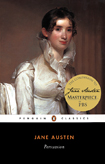Persuasion
by Jane Austen
- Overview
- Before Reading the Novel
- While Reading the Novel
- After Reading the Novel
- Extended Learning
- Bibliography
- About the Guide Author
- About the Guide Editors
- Buy this Book!
Enter promo code TEACH for 15% off.
INTRODUCTION
Persuasion by Jane Austen is a novel rich in intrigue and romance. Although Austen's focus seems to be the manners and morals of the time, this concern is embedded in the tentative relationship between Anne Elliot and Captain Frederick Wentworth and in whether the relationship will flower again to the heights of the love they once had.
On the most basic level Persuasion is a love story, both interesting and entertaining. On a deeper level it examines human foibles and societal flaws. The question of the importance of propriety is raised frequently as is the issue of appearance vs. reality.
Family relationships and duty to family are both foci of the story. Within this family context relationships between men and women are examined, and it is interesting to see how male and female relationships have changed since the early 19th century. Of course, love and marriage are at the center of the story since it is through love that Austen brings into play most of the other issues.
For fans of television soap operas, the subtleties of the novel will leap to life. For those raised on action/adventure stories, the plot will seem slow. The novel's lack of action and antiquated language and mores will probably be the biggest hurdles teachers will face in involving students in reading Austen's novel. This teacher's guide encourages student involvement through activities that help students explore the subtleties of the novel.
Too often teachers overwhelm students with background knowledge when teaching classics like Persuasion. Explaining the time period and differences in customs and place, providing background on the author, and highlighting vocabulary and concepts overloads students with information rather than whetting their appetites to read the book. When the teacher is the authority, the student is removed from the exciting role of discoverer and placed in the very unexciting role of passive receiver of information. Sharing information with students as they raise questions is more effective than overwhelming them with information out of context.
The goal of this guide is to help you establish an interactive classroom in which students share written responses in small groups and then with the whole class. Its emphasis is on discovery and involvement. Discussing and debating issues and opinions encourages students to return to the text to support their assertions. This delving into the novel for information important to the student is infinitely more motivating than digging through to answer teacher-made questions.
Although this guide has an abundance of activities and questions, the intent is to give teachers and students choices. It is not important or even desirable to have students respond to every chapter. More realistically, you might ask students to respond to one suggestion for every four or five chapters read. Students can share their work in small groups, raising the interest of other students. It is important to vary the activities and keep the work interesting by letting students use their imaginations as they demonstrate their involvement in the book.
This guide is divided into three sections. The first section provides background information to assist you in answering student questions. The Overview contains a brief biographical sketch of Jane Austen, historical background for the novel, and information on Bath, the setting for much of the book. The second or Teaching section of the guide contains activities arranged for use either before, during, or after reading the novel. The third section provides ideas for Extending the Students' Learning beyond the novel.
OVERVIEWSummary of Characters
The following summary of characters in Persuasion is meant to provide a brief overview. No plot summary is included here because chapter summaries are given later.
Persuasion centers on the Elliot family – Sir Walter and his three daughters Elizabeth, Anne, and Mary. Told mainly from Anne's perspective, it is the story of her father's reaction to his overspending, Elizabeth's responses to those she views as less important than herself, Mary's settling into married life with a family she feels is socially inferior, and Anne's quest to rekindle the romance she once had with Frederick Wentworth. Minor characters all have a definite purpose in the novel: Mrs. Russell is the family confidante; Mr. Shepherd handles the family's legal affairs; while his daughter Mrs. Clay is vying for the affections of the widowed Sir Walter Elliot. The whole Musgrove family, from Mr. and Mrs. to Charles and Henrietta and Louisa, are able to enjoy themselves without suffering unduly over their places in society. Admiral and Mrs. Croft exemplify true love in a happy marriage. Mrs. Smith, Anne's friend, provides important information on other characters while showing off Anne's true character. Through the characters of Captain Harville and Captain Benwick, readers see another side of Captain Wentworth and are also provided with a solution to Wentworth's entangled relationship with Louisa. Each character is necessary to keep the threads of the plot closely intertwined around the affairs of Anne and Captain Wentworth.
Historical Commentary
This brief commentary points out some basic differences between late 18th-/early 19th-century society and 20th-century society that can become topics for classroom discussion.
The Austens were members of the landed gentry, part of the hereditary ruling class of England along with the aristocracy. Although many of the landed gentry simply lived from the profits of their estates, younger brothers did not inherit and often had to turn to careers in the army or navy or to respectable occupations in banking, law, or government. Identity was not based on occupation, but on class.
Although Jane Austen recognized some of the flaws of her society, many aspects of it go unquestioned. The right to be part of the gentry and to have privileges simply by virtue of birth is never raised as an issue. Also unquestioned is the belief that Englishmen and English institutions were superior to any others in the world. War is also taken for granted as one way to make a fortune - no questions are ever raised about whether or not this is ethical.
People's place in society was also viewed differently. Humans were not seen as individuals, but rather as social beings judged by their conduct toward each other. Individual desires and accomplishments were not of major importance. Manners were looked upon as another aspect of morals, and politeness was elevated to a virtue. Social interaction was the expression of late18th/early 19th century society much as individualism is the expression of 20th-century society.
Being civilized and having good sense were vitally important attributes. The emphasis on being part of society carried over into views of family life. Family duties were especially emphasized because the family was seen as the natural unit around which society was built and maintained. This notion of duty to family and society may be difficult for today's students to understand because they have been brought up in a society that views individual happiness as a major goal.
The common view was that women were in charge of private life, while men were in charge of public life. Because women were not in public life, they could not own property or inherit from their fathers - they had no legal rights. Thus the only route to financial stability open to women was through marriage.
A Note on the City of Bath
The city of Bath was the most popular place for the aristocracy to vacation in the early part of the 18th century. It was a beautiful, planned city with wide streets laid out in an orderly fashion. Bath was named for its hot, healing waters that had been enclosed in buildings by the Romans.
By the beginning of the 19th century, the time period of Persuasion, there was not as much activity in Bath, since the nobility preferred seaside towns like Brighton for their holidays. Bath, however, was still frequented by the landed gentry, who often viewed it as a good retirement city. Social activities in the Pump Room and the Assembly Rooms were not as frequent as in years past, but they were still the scenes of social gatherings.
It is easy to understand why people of any century find Bath a pleasant place. Hills surround the city, a river runs alongside it, and the town itself is inviting. At the top of the hill sits the Royal Crescent, a long group of townhouses built in a crescent shape, and still the city's most prestigious address. Sloping down the hill in front of the Royal Crescent are beautiful gardens with walking paths. On the hill not far from the Royal Crescent are the Assembly Rooms, renovated in the late 20th-century to give visitors a glimpse of the way they looked in their glory days. Lining both sides of Pulteney Bridge are shops built into the bridge itself. Beyond the bridge is the beautiful Laura Place where Lady Dalrymple lived.
Today, the baths have been restored and the Pump Room turned into an elegant restaurant. Outside the Pump Room is a large, cobbled courtyard. It is easy to imagine the characters in Jane Austen's novels promenading up and down to see and be seen. The center of the city is crowded with little shops on narrow, cobbled streets. Walking around the city is as pleasant today as it must have been in Jane Austen's day.
Austen's Life
Jane Austen, born in 1775 in Hampshire, England, was the seventh of eight children. As a parson's daughter she saw many aspects of life, including poverty and death. Through her father's work and her travels with her family, she had a wider variety of experiences in life than her depiction of herself as an isolated spinster would imply. Educated by her father, she began to write as a child and continued this practice throughout her life.
Jane had a rich inner life nourished by the many books she read, the plays she attended, and the people she knew. Because life for women was so centered around home and family and community, social activities held a prominent place in her life. Jane was very observant and her keen eye and ear allowed her to capture the intricacies of human interactions as well as the manners that surrounded those relationships on paper.
In 1802 it is thought that Jane experienced a deep love affair, but that the young man died a few weeks later. Within the year she refused a proposal from a family friend and never married. Jane gave most of her energy to her large, extended family and to her writing. Her novels include: Sense and Sensibility, Pride and Prejudice, Mansfield Park, Emma, Northanger Abbey, and Persuasion.













